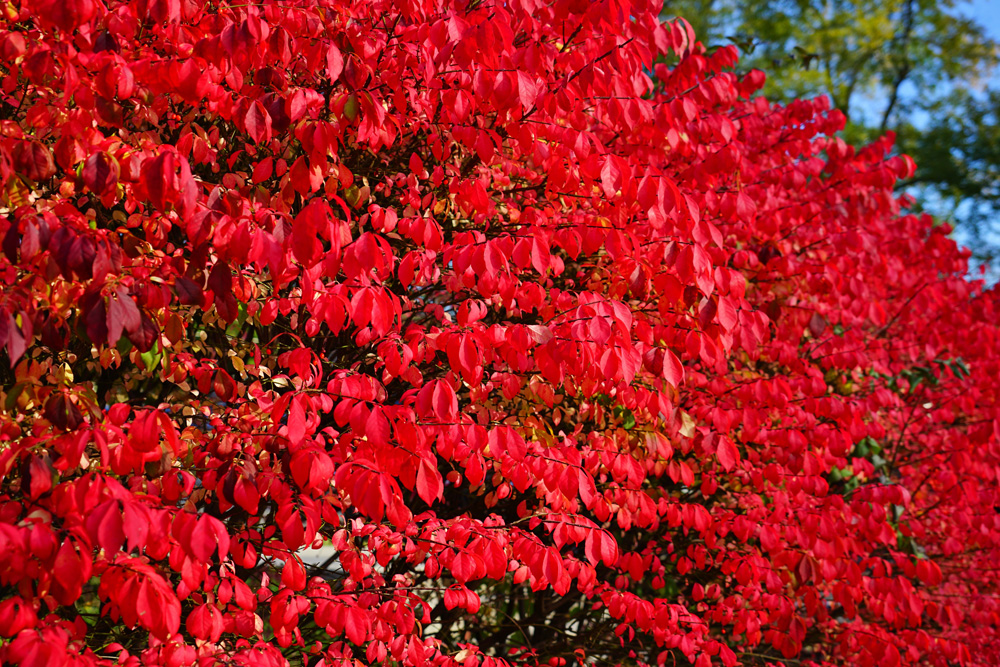Euonymus sp.
Common Name:
Burning Bush

General information:
The spindle tree, or burning bush, is popular as an ornamental shrub for its brilliant red autumn coloration and for the interesting “wing” structures which form on the branches. Bonsai enthusiasts differ on this point: Jahn and Tomlinson, for example, finds the wings an interesting feature, whereas Murata considers them a nuisance. Both evergreen and deciduous varieties of spindle tree can be used for bonsai.
Lighting:
Needs a lot of indirect light, but only limited exposure to full sun.
Temperature:
Varies according to species, with some Euonymus being quite hardy (to zone 4) while others being considerably more tender. Tender varieties can be kept indoors during winter, but need outdoor light and air come spring. Small sized Euonymus bonsai need frost protection for their roots.
Watering:
Moderate. Do not allow the soil to dry out. May appreciate daily misting during growth.
Feeding:
Every two weeks from late spring through summer. Use bonsai food, half-strength plant food or timed-release pellets.
Pruning and wiring:
Cut back new shoots to 2-3 leaves. Can be wired during spring and summer, but protect the delicate bark. A single plant will flower, but if fruiting is desired, several specimens are required for cross- pollination. E. sieboldianus has naturally long internodes, and Murata warns that attempting to make the tree look “restrained” will seem artificial. He encourages bonsaists to appreciate the “unrestrained” nature of the tree. Those who find the wings unattractive or out of proportion in their bonsai often choose to remove them.
Propagation:
Seed, layering in spring or summer, softwood cuttings in summer, hardwood cuttings in autumn.
Repotting:
Every 2-3 years in early spring, although yearly repotting may be necessary during the tree’s first ten years depending on root growth. Use basic bonsai soil mix.
Pests and diseases:
Caterpillars, aphids.
Some species suitable for bonsai:
Euonymus alatus: winged spindle, burning bush, corkbush, winged euonymus - Remarkable autumn color, with purple-pink leaves and small orange fruits. Originally native to northeastern Asia, it can grow to 15 feet. Hardy in zones 4-8.
Euonymus alatus form. ciliatodentatus: ko-mayumi, spindle tree - This particular Euonymus lacks the “wings” which characterize most of the species.
Euonymus bungeana: winterberry euonymus
Euonymus - Burning bush
Euonymus europaeus: European spindle-tree - Another colorful Euonymus, with scarlet seed capsules and pinkish-orange fall color. This European native is taller than other Euonymus species, growing to 20 feet. Hardy in zones 4-7.
Euonymus fortunei: wintercreeper euonymus - Youthful plants assume a creeper habit which is suitable only for cascades, but the mature plant develops a bushy habit and a firm woody trunk. Cuttings taken from older plants retain the bushy habit. Has many forms, most frequently variegated. Hardiness depends on the variety, with some forms able to survive New England winters, but some tender variegated forms.
Euonymus japonica ‘variegata’: Japanese spindle tree, evergreen euonymus - This evergreen can be brought indoors for the winter where it is not zone hardy. A winter temperature of 46-59F is preferable. It grows to 12 feet, and has glossy leaves reminiscent of box. Hardy in zones 7-9.
Euonymus kiautschovica: spreading euonymus - The smallest Euonymus, it grows only to 10 feet. Evergreen in the warmer areas of its range, but in colder climates may lose many of its leaves and emerge from winter looking ragged. Hardy in zones 6-9.
Euonymus sieboldianus: Japanese spindle tree - pale green flowers, pinkish-white fruits and red seeds.
Euonymus sieboldianus cv. ‘Fastigiatus’: tachi-mayumi, spindle tree.
Compiled by Sabrina Caine Edited by Thomas L. Zane
